Chaos de Montpellier-le-Vieux
Useful Information
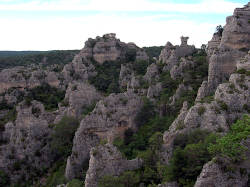
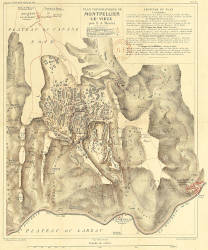
| Location: |
Parc naturel régional des Grands Causses (Grands Causses Regional Natural Park.).
(44.137829, 3.203223) |
| Open: |
APR to JUN daily 9:30-17:15. JUL to AUG daily 9:30-18:15. SEP to OCT daily 9:30-17:15. Mini train: 11, 14, 15, 16. [2023] |
| Fee: |
Adults EUR 8.90, Children (5-18) EUR 6, Children (0-4) free, Students (-26) EUR 8.10, Unemployed EUR 8.10, Disabled EUR 8.10. [2023] |
| Classification: |
 Limestone Pavements Limestone Pavements
 Stone Forests Stone Forests
 Bare Karst Bare Karst
|
| Light: | n/a |
| Dimension: | Ar=120 ha. |
| Guided tours: | self guided |
| Photography: | allowed |
| Accessibility: | no |
| Bibliography: |
Edouard Alfred Martel (1884):
Le Causse Noir et Montpellier-le-Vieux,
Annuaire du Club alpin français 1884, pp 263-291.
 online
online
Edouard Alfred Martel (1885): Auvergne et Cévennes 1883-1885, Annuaire du Club alpin français 1885, pp 213-235.  online
online
|
| Address: |
La Cité de Pierres Montpellier-le-Vieux, Lieu dit Le Maubert, 12100 Millau, Tel: +33-565-60-66-30.
E-mail: |
| As far as we know this information was accurate when it was published (see years in brackets), but may have changed since then. Please check rates and details directly with the companies in question if you need more recent info. |
|
History
| 1883 | discovered by the Malafosses and Monsieur de Barbeyrac-Saint-Maurice. |
| 1884 | explored by Edouard-Alfred Martel. |
Description
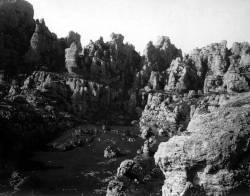
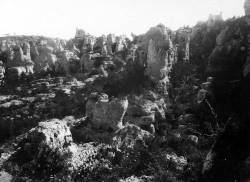
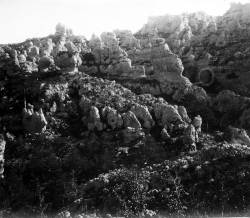
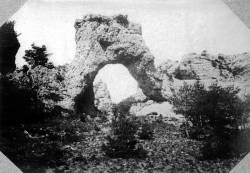
The Chaos de Montpellier-le-Vieux is a stone forest, a bare karst area with strange limestone rocks, forming pillars and natural bridges. There are karren and limestone pavements. It is located east of the village Millau, bordered by the rivers Tarn and Jonte in the north, and Dourbie in the south. The D110 crosses the Causse Noir plateau today. It allows access to several via ferratas and the Visitor Center at Montpellier-le-Vieux.
The area has six different trails, which offer ten outlooks, and 30 explanatory tables in the languages French, English, German, Dutch, and Spanish. The trails are marked with different symbols. A map is available in the Visitor Center at the entrance.
- Le Belvédère: An easy hike to La Porte de Mycènes, it’s possible to return by mini-train. (50 minutes)
- Les Remparts: Panoramic ridge, leading to the summit of the Douminal (840 m asl) with an orientation table. (50 minutes)
- Le Magnifique: Balcony above the deep gorges of the Dourbie, leads to the outlook Le Magnifique. (30 minutes)
- L’Arborétum: A more sporty trail through a forest with 16 species of trees. (50 minutes)
- Le Labyrinthe: a branch of the Arboretum circuit, the Labyrinth of the Canauls, 1 m wide and 50 m high cracks. (30 minutes)
- Les Geants: Walk through several rock formations called Le Roc Camporolié and L’Arc de Triomphe. (30 minutes)
The limestone was deposited 170 Ma ago during the Jurassic, when the area was covered by a shallow, oxygen rich sea. It was full of atolls with coral reefs, in which many sponges, molluscs, sea urchins and crustaceans lived. The climate was tropical and the water was warm. Over 10 Ma a 300 m thick layer of limestone was deposited. The uplift was a side effect of the Pyrenean orogeny, about 80 Ma ago. The limestone got cracks, which became the path for rainwater. The carbonic acid in the water dissolved the limestones, widened the cracks and thus created the wild rock formations.
The name Montpellier-le-Vieux was given to the area by shepherds of the Languedoc plains. They thought it was a ruined city, and the only city they knew was Montpellier, so the called it "ruined Montpellier". Also, the Occitan nickname of Montpellier is Lou Clapas which means “pile of stones”. In the Occitan language, vieux (old) is vielh (pronounced biel). The term also refers to the Devil in folk stories, so Lo Clapas del Vielh also means Devil’s Stones, Devil’s Ruins, or Devils City or La Cité du Diable. In the Middle Ages in Occitan, huge natural formations or even ancient architecture were attributed to satanic beings or giants.
Three fairies from the southern garrigues once fled from Mourghi, an evil spirit who wanted to harm them. Amy the thoughtful, Amyne the dreamer, and Benjamin the joker arrived at this place one evening in May. They very quickly built a citadel with ramparts, streets, palaces, bridges and squares. Then they planted pine trees, some oak trees, and a lot of wild grasses and wildflowers. The result was a labyrinth, and when Mourghi finally found the place, he got lost and gave up his hunt. A long period of peace, happiness and quiet joy for the fairies began. But some time they became homesick for the garrigues and they returned to the sea and the sun. The city then fell asleep in their absence. Then, undoubtedly summoned by some devil, the wind, rain and snow raged through the now dead city. The fairies have left but their memory still lives in the city, in the song of the birds, the sound of the wind, the bells of the herds. The echoes of Benjamin’s laughter can be heard, the image of the evil Mourghi is in the trees, the image of Amyne’s dream in the rocks. The fairies, masters of dreams, are still there.
Edouard Alfred Martel was the first speleologist of the world. He explored caves, documented his discoveries and published them in books. He started surveying caves and explored numerous karst related features. And he started his research in the Causses, while on holiday. It is not surprising that he explored, surveyed and described the Montpellier-le-Vieux. And he renamed the formations in his description and called the site La Cité de Pierres (The City of Stones). For example, the Eye of the Devil (L’Oeil du Diable) was renamed La Porte de Mycènes. The 30 most spectacular rock formations are named after monuments of the antiquity or architecture, together they are called Roc’Art, because they resemble sculptures.
«Le Causse Noir est le plus riche de tous ces amas de rocs ruiniformes : Montpellier-le-Vieux, leur capitale… compte parmi les villes de rochers les plus remarquables du monde»
"The Causse Noir is the richest of all these heaps of ruiniform rocks: Montpellier-le-Vieux, their capital... is one of the most remarkable rock cities in the world.
Edouard Alfred Martel
 Search DuckDuckGo for "Chaos de Montpellier-le-Vieux"
Search DuckDuckGo for "Chaos de Montpellier-le-Vieux" Google Earth Placemark
Google Earth Placemark Chaos de Montpellier-le-Vieux - Wikipedia (visited: 06-FEB-2023)
Chaos de Montpellier-le-Vieux - Wikipedia (visited: 06-FEB-2023) La Cité de Pierres in Montpellier-le-Vieux (visited: 06-FEB-2023)
La Cité de Pierres in Montpellier-le-Vieux (visited: 06-FEB-2023) (visited: 07-FEB-2023)
(visited: 07-FEB-2023) Index
Index Topics
Topics Hierarchical
Hierarchical Countries
Countries Maps
Maps